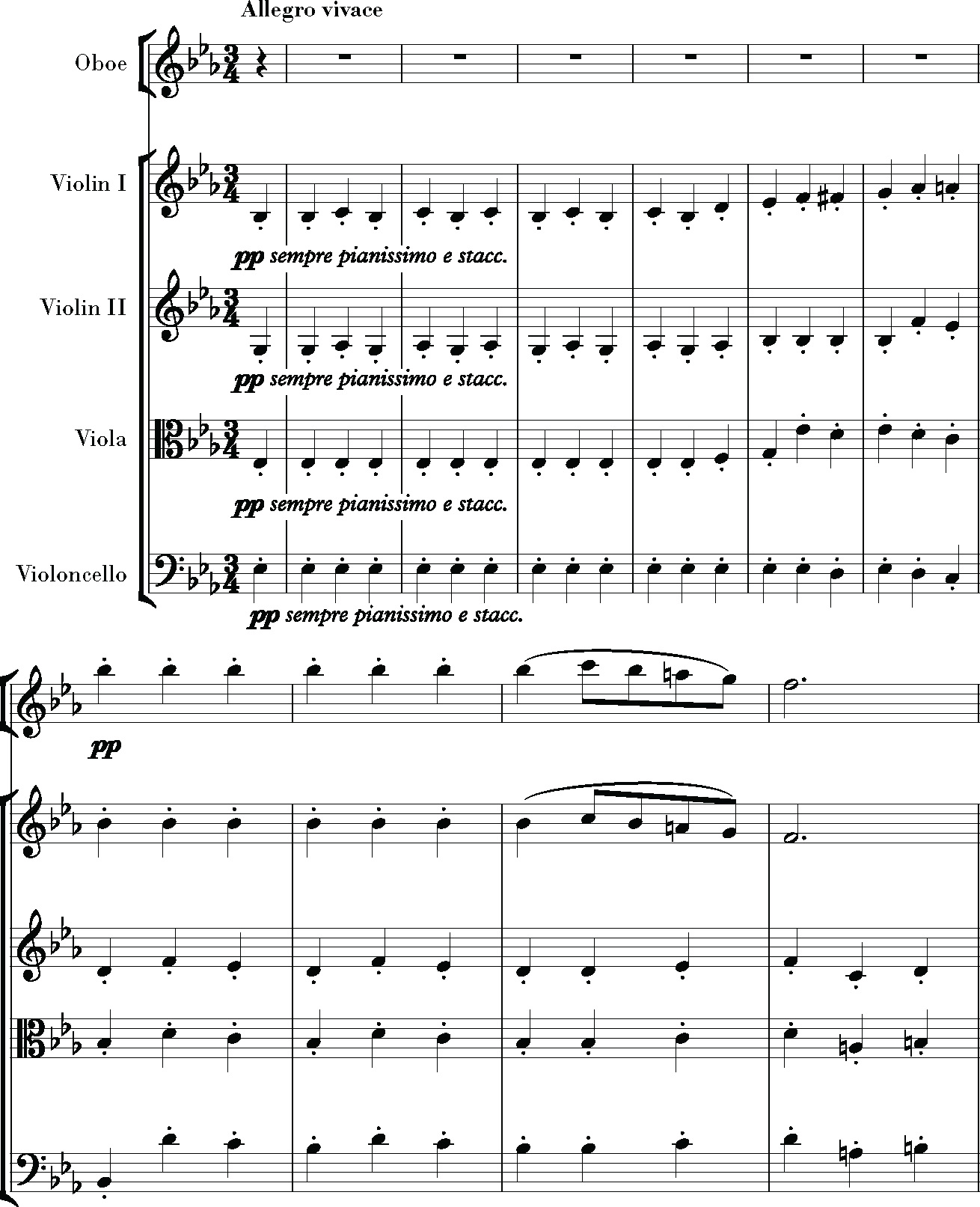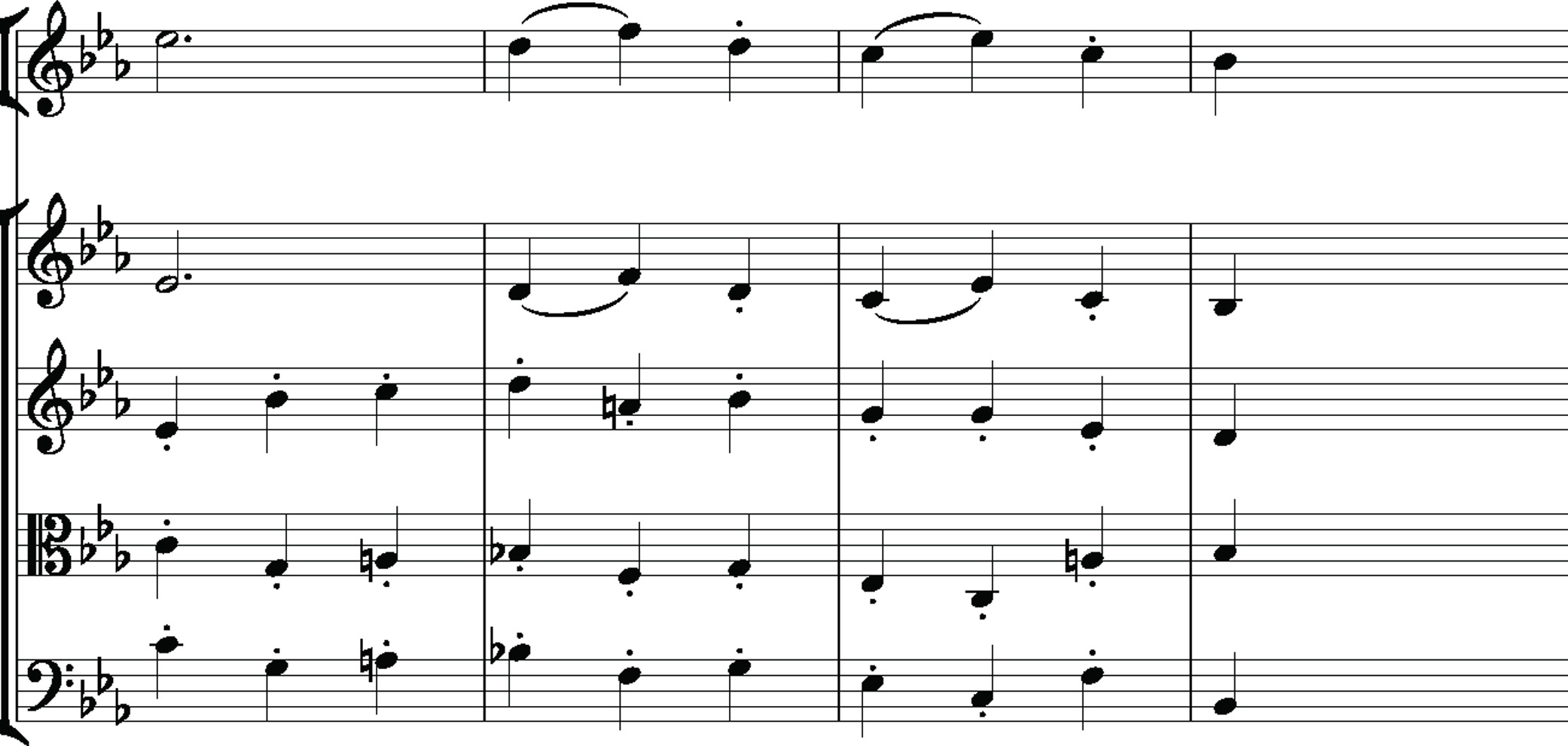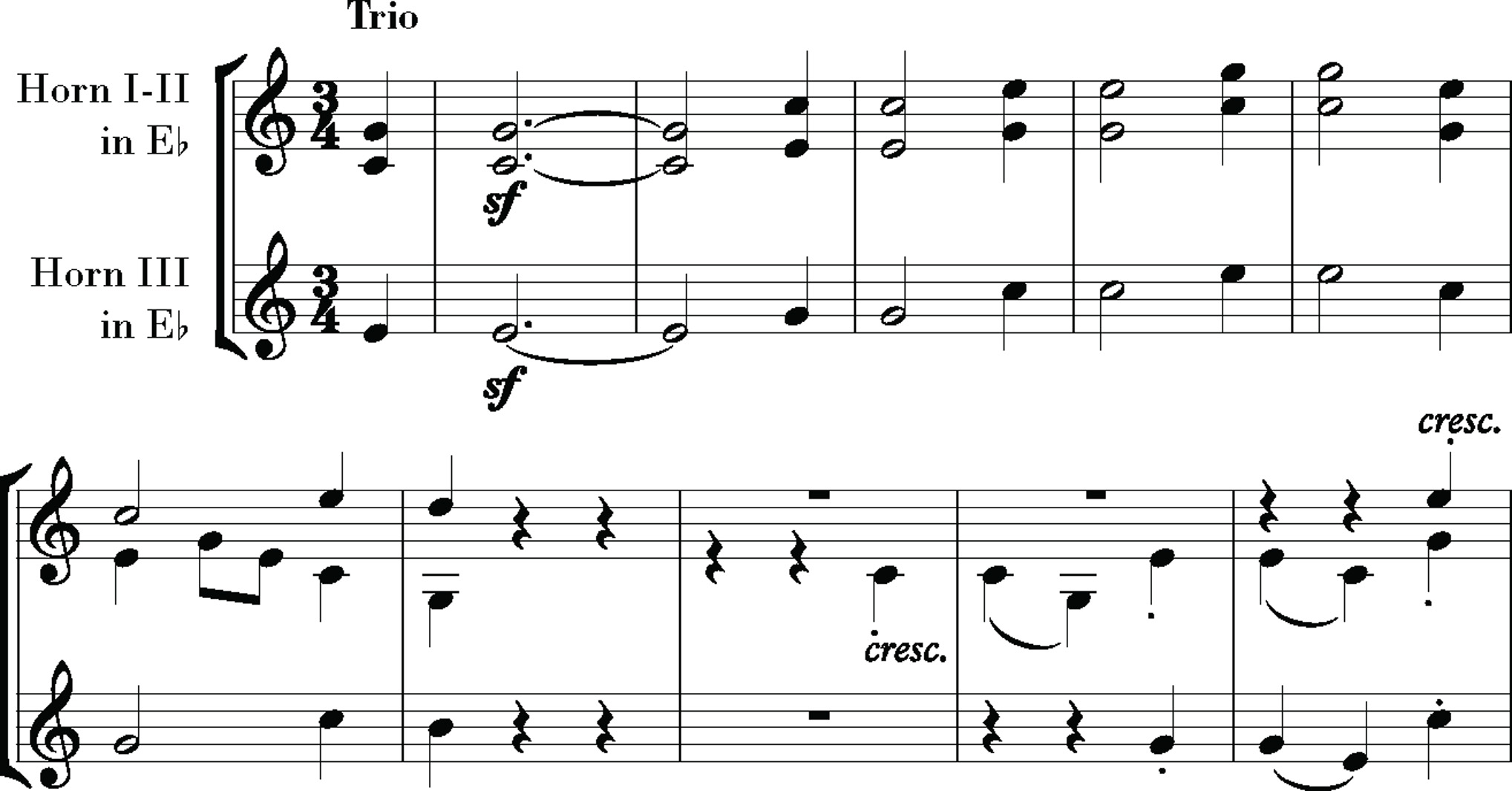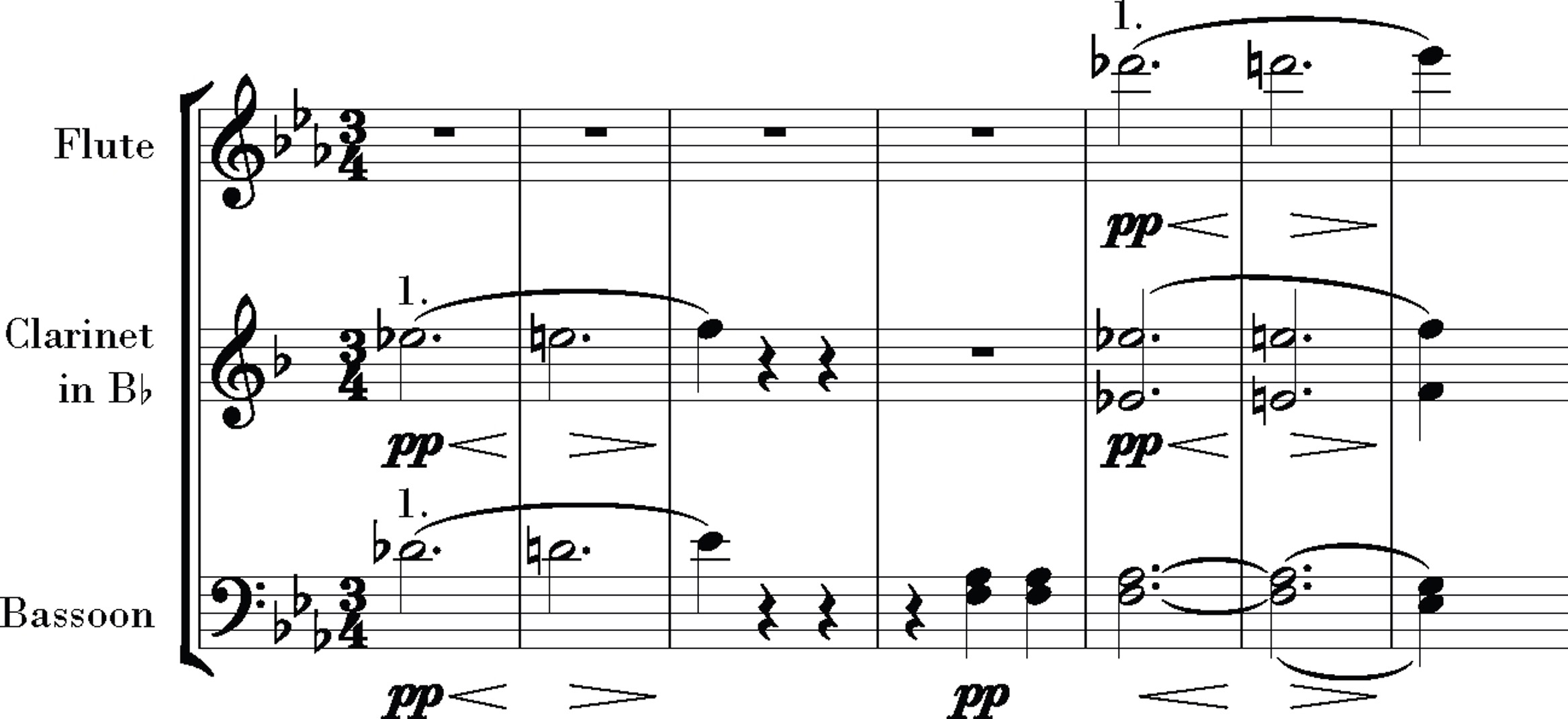Beethoven: Anguish and Triumph (58 page)

Â

Â
From there the scherzo takes shape quickly.
44
The two basic ideas of rushing figure and folk tune (most essentially in the oboe), steadily varied, modulating, sometimes taking the form of intricate chromatic windings, will be material for the movement proper. The movement is dashing, impetuous, quicksilver, the form taking shape with reference to traditional minuet-scherzo form, adapted and expanded. One singular feature is that after an opening indistinct murmur in E-flat, the music moves to B-flat and first presents its little oboe tune in that key, then in F, then in B-flat again. Only then,
tutti fortissimo
, horns leaping upward, basses following the theme in canon, does the tune arrive in the home key of E-flat with a joyous sense of
Aha!
The model for this procedure is the first movement, where the Hero theme is heard quietly twice before its
tutti fortissimo
eruption.
45
In some ways, the 3/4 scherzo is an echo of the 3/4 first movement lightened, accelerated, electrified.
Â

Â
In the trio section of the scherzo, he revels in his trio of horns in their primeval role as hunting horns. The classically virile, crowing theme is based on a triad, making it another avatar of the first movement's Hero theme:
Â

Â
Â

Â
The coda begins with a
pianissimo
whisper, and there he places (from measure 425) the “strange voice” he had noted in the first sketch:
Â

Â
The keening chromatic slide D-flatâDâE-flat does sound like a voice from somewhere outside the scherzo (though its notes are already there in the violins a few measures earlier). And indeed, the figure is from outside: the “strange voice” answers the downward chromatic slide E-flatâDâC-sharp on the first page of the symphony that created a harmonic kink, the C-sharp a sore note that has resonated ever since. Here, at the end of the scherzo, after its adventures as both C-sharp and D-flat, the sore note resolves up to the tonic note. From there, the music gathers strength and intensity, just as did the coda of the first movement, up to a
tutti fortissimo
finish in three curt staccato chords. (All the movements end with staccato chords.)
From the sketches, then, it appears that he started the third movement at first with little clear sense of it, either its material or perhaps even its genreânot sure whether it was minuet or scherzo. But when the ideas appear and become
presto
, the movement takes shape as a stretch of effervescent exhilaration. As the
Marcia funèbre
followed the battle, the scherzo follows as the end of burial and mourning: the return to life and to joy. That journey, from suffering to joy, is a story Beethoven enacted over and over in his music, and in the whole of his life.
Â
For Beethoven to begin work on the finale is to arrive in familiar territory: the
basso
and
englische
themes he has handled three times before and decreed from the beginning will be the goal of
Bonaparte
. He knew from the beginning that his approach here would echo the treatment in the
Prometheus
Variations for piano: after a new introduction in the context of the symphony, he will start with the
Basso del Tema
and add voices until the
englische
tune arrives. He will quote none of the variations from the piano version, only the
basso
and tune. The variations have to be redone for orchestra and for a new purposeâat once an arrival, a fulfillment, and an apotheosis.
46
The qualities musical and humanistic that Beethoven found in the
englische
are manifest in its being the foundation of two major sets of variations, one for piano and now this one for orchestra. After the rise and victory of the Hero, the burial of the dead, and the scherzo's return to life and joy, the music arrives at the gift the Hero has given to the world. Recall Schiller's words on the
englische:
Â
I can think of no more fitting image for the ideal of social conduct than an English dance, composed of many complicated figures and perfectly executed. A spectator . . . sees innumerable movements intersecting in the most chaotic fashion . . . yet
never colliding
. . . It is all so skillfully, and yet so artlessly, integrated into a form, that each seems only to be following his own inclination, yet without ever getting in the way of anybody else. It is the most perfectly appropriate symbol of the assertion of one's own freedom and regard for the freedom of others.
47
Â
Here is the meaning of the simple contredanse that underlies a heroic symphony: the
englische
as image of the ideal society, the conquering Hero's gift to humanity. As in the other movements, it is a dramatic and symbolic image adumbrated in musical form.
48
Â
Like the scherzo, the finale falls quickly into place for him. The first sketch is the first four notes of the
basso
, the head motif that in much of the movement will stand for the whole of the theme, as the first four notes of the Hero theme often served in the first movement. Next he writes down a rushing passage in sixteenths, in G minor. It evolves into the G-minor eruption that will begin the finale.
49
In the end that manifestly militant introduction storms only briefly. By the end of the first phrase, the music has turned into the familiar mode of an introduction to a dance, and the variation-finale proper is under way. The music conjures the atmosphere of the
Prometheus
ballet, the
Basso del Tema
run through alone and echoed jauntily in the winds. As in the ballet version, a suddenly loud three-eighth tattoo serves as a kind of refrain to the
basso
.
50
Its ending starts with the A-flatâG figure and brings the music back to the tonic, the home key. Like most sets of variations, and also like the music for an
englische
at a dance, the finale will have a series of contrasting sections with changes of mood and tempo.
He gathers the variations over the
basso
as he did in the piano version: the music first in two parts, then three, then four. In the third variation he arrives at what the music was searching for, the sprightly little
englische
tune, first in the light mode of a dance, then suddenly loud, assertive, undergirded with rocketing bass lines. From its beginning,
the goal of the symphony is the
englische. Which is to say, this dance and the ideal society for which it is a symbol are going to be exalted. The idea of an apotheosis in dance was implicit from the beginning. The Hero theme of the first movement was not a martial figure but a dance on the order of a waltz, and its half-and-quarter trochaic rhythm foreshadowed the dotted-quarter-and-eighth trochees of the
englische
. At the same time, the first three notes of the Hero theme are the same as the beginning of the
englische:
E-flatâGâE-flat.
Once more Beethoven fashions a singular, ad hoc form for the finale, less a series of variations in discrete blocks than a movement that will gather, swell, intensify toward the end. In his sets of variations since childhood, he has imposed overarching plans, and so it is here. It is the particularities of the plan, the interweaving of material, the gathering of threads from earlier movements, the multidimensional form, that make this movement unprecedented, more pointed and forceful than variations tend to be. The finale will be kaleidoscopic, like the first and second movements. Like the first movement it will be a kind of ongoing process, but with more sustained themes and a sense of stylistic evolution and transformation.
Within the overall process of intensification, he lays out the finale in four large sections, though the effect is more continuous than strongly marked. The first section reaches the
englische
and develops it at length. The second section (from measure 117) leaves E-flat for C minor, starting as a double fugue (constituting variation 4) on a motif from the first variation combined with the
basso
(this recalls fugues in the
Marcia funèbre
and in the first movement). The fugue dissolves into variation 5, a quiet recall of the
englische
in distant B minor / D major. That reversion to a dance style leads to a climactic
fortissimo
in triplets, reminiscent of the scherzo. Variation 6 is a real march at last, the first one in this work whose subject is a military hero: a “Turkish”-tinged march in G minor, the style familiar from the military music of the day, the effect like a passing parade of soldiers in a peaceful time.
The third section of the finale builds to an apotheosis of the
Basso del Tema
. It starts with variation 7, another quiet recall of the
englische
in C major. Variation 8 is another
fugato
over the
basso
, in E-flat major. With that Beethoven makes a peculiar decision, to return to the home key in the middle of a section,
pianissimo
.
51
But this is a return of many things, another gathering of threads. Figures in the
fugato
recall the C-sharp/D-flat sore note and GâA-flat motif going back to the first page of the symphony.